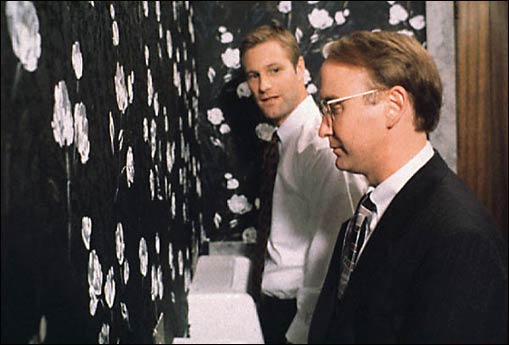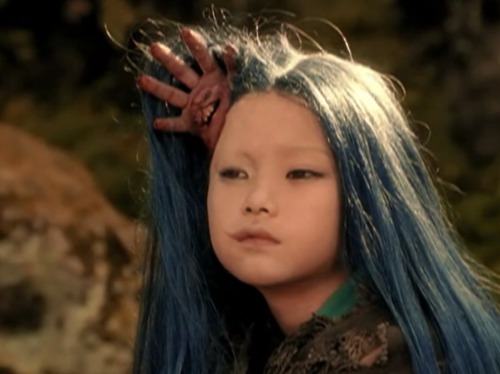I was recently inspired by a Pop Crunch top 15 most disturbing movies piece to take my own shot at what I consider to be some seriously freaky cinematic offerings. Enjoy.

Turns out, using heroin is a bad idea. Who knew?
5. Requiem for a Dream. For you fans of Black Swan, that’s director Darren Aronofsky’s third most disturbing film, behind his debut – Pi – and this adaption of Hubert Selby Jr.’s novel of the same name. There’s plenty of dark, graphic images in Requiem, but what is most disturbing is being forced to sit and watch helplessly the long, slow descent by the main characters as drugs overwhelm their lives. Aronofsky never flinches, as well as getting amazing performances by Ellen Burstyn (who was nominated for an Oscar), Jared Leto, Jennifer Connelly and – of all people – Marlon Wayans. The movie was released in theaters unrated as the MPAA wanted to slap an NC-17 on what might be one of the greatest “just say no” films of all times.

“In the Company of Men” returns to relevance with the recent attention shown the online pro-man/misogyny movement.
4. In the Company of Men. The debut of both writer/director Neil LaBute (Nurse Betty, The Wicker Man) and actor Aaron Eckhart (The Dark Knight, Erin Brockovich) was an indie film made just down the road from my hometown of Muncie in Fort Wayne, Ind. Two men – the lethario Chad (Eckhart) and his nerdy pal Howard (Matt Malloy) – decide to play a game with the new girl at work, the deaf Christine: They want to ruin the poor, innocent young woman’s life. She’s done nothing to them. They’ve just had it with women, and Christine is chosen to be the target of their wrath. It’s misogyny at it’s “finest.” This isn’t a bloody film. The damage is all psychological and absolutely disgusting. And you’ll never forget the ending.

There will be blood should you choose to watch “Ichi the Killer.”
3. Ichi the Killer. I always laugh when the media, pundits and politicians attempt to draw direct correlations between violence in music, movies, video games, television, etc., and the acts of what are usually selfish, mentally unstable (at best) individuals. Ichi may be the one exception, where I sat there thinking “If some messed up individual watched this, the fallout could be awful.” The title character is a gangster with a pain fetish, in constant search of the sadomasochistic act that will bring the ultimate, exquisite joy. The first of Japanese horror maestro Takashi Miike’s films to make my list is painted richly with pain and blood. Ichi shows no mercy to himself or others and takes pleasure in all of it. Not a bad movie, but not easy to watch.

Does watching a three-care pileup turn you on?
2. Crash. No, not that Crash. I’m writing about the 1996 film directed by David Cronenberg is based on the book by J.G. Ballard. It’s about a small subculture of people who gain sexual pleasure from watching and being involved in car crashes, even from pictures and films of accidents or the resulting scars, braces and other medical side effects. James Spader and Deborah Kara Unger play a couple with an open marriage who can’t seem to sexually excite each other unless they are talking about their various affairs. Spader gets in a car crash, meets fellow crash victim Helen Remington (the awesome Holly Hunter), and they venture further and further into this world of screaming steel and broken bones. Crash is voyeuristic, putting its audience in the position of feeling like it shouldn’t be watching these disturbing, intimate moments. Oddly, it’s also a story about a couple with a failing marriage who end up closer as a result of their acts. Yes, Crash kind of has a happy ending (no pun intended), in its own unique, disturbing way.

Not even close to the most #$%&ed up thing you’ll see in Takashi Miike’s “Imprint.”
1. Imprint. So in 2006, Showtime purchased this Masters of Horror anthology that included works from big names like John Carpenter and Tobe Hooper. The idea was to give the directors a budget and let them loose to make a one-hour film, no limits imposed beyond the funding. Takashi Miike created Imprint, gave it to Showtime, and Showtime said, “No way. Uh-huh. Not touching this.” My guess: Part of the background story involves showing what abortion would have been like in the late 1800s, when this story is set. Let’s just say pulling a fetus from the womb then wasn’t much different than pulling a calf. Miike shows the process, not allowing the viewer the opportunity to look away. I’m betting Showtime saw crowds holding signs with pictures of aborted fetuses outside their headquarters as a future implication of Imprint‘s release – along with the accompanying media attention – and decided it wasn’t worth it.
What’s interesting, really, is that the abortion ends up being the third or fourth most disturbing thing that happens in this movie. A familiar face of the horror genre, Billy Drago, plays a journalist, Christopher, who is in love with a Japanese prostitute, Komomo. He must return to America, but promises to come back and marry Komomo. But by the time Christopher returns, Komomo has been sold off and has disappeared. The viewer joins Christopher as he arrives at a distant, remote end-of-the-line island, a small world away from the prying eyes of the law or morality. Christopher is told Komomo is no longer there, and he must stay the night before he can move on. He takes shelter with another prostitute. As the night progresses, the girl tells Christopher Rashomon-like stories of what really happened to Komomo, each time telling more of the truth as Christopher tries to cut through the lies. By morning, when she has arrived at the truth, Christopher has gone mad and kills the prostitute.
Two things really are what drive the dread in Imprint. First, we don’t know if any of this has really happened. The ending makes it clear that Christopher could have been insane the entire time, consumed by guilt and driven to madness by other actions. Did he imagine it? Much like Miike’s absolutely stunning The Box, this haziness is a core part of the tale.
Second, what is horrifying isn’t the story of the second prostitute’s life, although it is awful. It isn’t even that Komomo is tortured to death by her fellow prostitutes when Komomo is accused of theft she didn’t commit and won’t admit to having committed. It’s that these prostitutes relish what they are doing to Komomo. They have no hope. They realize that this island is their last stopping place, and that their ends will come soon, probably brutally. That Komomo has hope, that she has someone who loves her and will follow her to the end of the earth, that they cannot abide. The torture is about making her lose that faith, crushing that belief that her life will have a happy ending, lowering her to their level. Imagine Eli Roth directing Mean Girls. It isn’t the blood and the blades and the deady baby. It’s the horrible capacity of humanity to demean and destroy others for what is really the best in humanity that will stick with you in the end.






